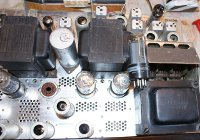    |
The
Harman Kardon TA-5000 tube stereo receiver "The Award Stereo
Festival". It was a modernized version of TA-260 with MPX stereo
decoder. Made in the USA and made on exclusively American parts
(because HK t in those years was an American company). Aluminum
chassis with metal knobs. The measured power of the receiver with a
sine signal is 2 x 14 W, but the musical power is almost twice as
much. The power given by the manufacturer is 2 x 25 W. The amplifier
works in a Push & Pull configuration in the AB class (with a
deep advantage of class A). 4, 8 and 16 Ohm loudspeakers. There is
no mono-stereo switch - there is a "BLEND" potentiometer, or "stereo
base". HK used a fairly good and simple stereo decoder on two tubes
- 6AV6 / EBC91 and 6BL8 / ECF80. The signal indicator in the form of
a magic eye was also abandoned and the "zero FM" tuning indicator
was used. At the same time, when receiving medium waves, this
indicator worked as a normal indicator of the signal level. A neon
lamp mounted on the radio scale informed about the reception of the
stereo signal. Neon tubes had one major drawback - quite wide
ignition voltage. Therefore, this indicator was not very stable.
Each of the AM and FM scales has its own light bulb informing about
work in this range. Originally, all lamps were signed by their own
company - "Harman Kardon", and as you can see, the power tubes are
still the original 7355 with the HK logo and the words "Made in
USA". Characteristic for the HK design was the use of ECC83 and
ECC82 tubes in the preamplifier and control stage. A peculiarity of
this construction is the separate bandwidth control (bass-bass,
treble-treble) for each channel. The TA-5000X had a "weaker" brother
- the TA-3000X on the 7408 power tubes, and a "younger" brother with
the 7591 power tubes - the TA-7000x. Visually and electronically,
all versions of the TA-x000x were almost identical. The last photo
of the bottom of the chassis shows the GND assembly cable that is
characteristic for this company's products, stretching parallel to
the front. A very simple and convenient solution.
  
|






